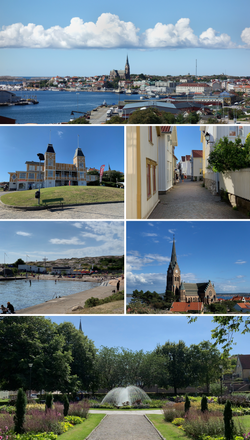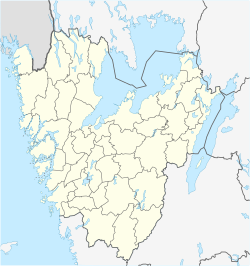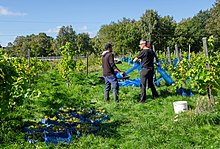| Lysekil | |
|---|---|
 From the top, left to right: Lysekil skyline, the Gentry Salon, Gamlestan, Pinnevik beach, Lysekil church, and the Town Park. From the top, left to right: Lysekil skyline, the Gentry Salon, Gamlestan, Pinnevik beach, Lysekil church, and the Town Park. | |
  | |
| Coordinates: 58°16′39″N 11°26′33″E / 58.27750°N 11.44250°E / 58.27750; 11.44250 | |
| Country | Sweden |
| Province | Bohuslän |
| County | Västra Götaland County |
| Municipality | Lysekil Municipality |
| Area | |
| • Total | 3.75 km (1.45 sq mi) |
| Population | |
| • Total | about 8,000 |
| • Density | 2,032/km (5,260/sq mi) |
| Time zone | UTC+1 (CET) |
| • Summer (DST) | UTC+2 (CEST) |
| Website | www |
Lysekil (Swedish pronunciation: [ˈlŷːsɛˌɕiːl]) is a locality and the seat of Lysekil Municipality in Västra Götaland County, Sweden. It had about 7,600 inhabitants in 2018. Situated on the south tip of Stångenäs peninsula at the mouth of Gullmarn fjord, it has two nature reserves.
Originally a small fishing village, it developed into a town for fishing industries, commercial shipping and trade during the 18th and 19th centuries. Stone industry based on the red Bohus granite from quarries in the town, was also vital to Lysekil up until the 1950s. One of Sweden's largest oil refineries, Preemraff Lysekil is situated outside the town.
During the 19th century, Lysekil was established as a prominent spa and bathing resort and tourism still makes up a large part of the town's economy.
History
Lysekil is first mentioned in 1570. It was originally an estate belonging to Lyse farm further inland. The population lived mostly on fishing and commercial shipping. The first settlement was on the north side on the tip of Stångenäs peninsula, where a natural, sheltered harbor is formed by a bay in Kornö fjord. The area is known today as North Harbour (Norra Hamnen). Before fixed lighthousees were built in the area, the local inhabitants would light false beacon fires, causing ships to run aground. Pillaging wrecks and also killing sailors who defended their stranded ships, was common along the coastline. During the Great Northern War (1700–1721), Lysekil was one of the harbors along the Swedish west coast where privateering became sanctioned by the government through the issuing of letters of marque. Charles XII of Sweden needed ships and men for the navy and one of the ways to get this was to give private ships and captains permission to seize and capture enemy ships and their crews.

When herring fishing peaked after 1750, fishing industries flourished in Lysekil. The main export products were salted herring and train oil made from boiled herring to extract the oil. During the Age of Sail, Lysekil became a center for fishing, shipping and transport. At the mid 1800s, the fishing village had a number of sailing ships. In 1909, 18 large sailing ships and 10 steamboats were registered in Lysekil. The harbor records that same year show 6,832 ships, including 185 foreign, coming and leaving.

During the second part of the 1800s, Lysekil developed into a bathing resort. The first warm water bath house was made from the cabin of a ship and the first real house was built in 1849. In 1859, Carl Curman became resident physician at the resort. He had studied the climate along the west coast and found Lysekil to be best suited for a spa town and through his contacts, the town became a resort favoured by the Stockholm socialite. New bathhouses, hotels and parks were built in 1864–1890 along the south side of the town, now known as the South Harbor (Södra Hamnen). Among those were the two Curman Villas built in Dragestil.
During World War II was one of the ports involved in Operation Bridford during which fast ships, called "Blockade runners", could break through the German Skagerrak mine blockade and ship ball bearings to Kingston upon Hull, England. The same route was later used to bring supplies and ammunition from Britain to the Danish resistance movement.
On 19 August 1961, the only collision between a car and a submarine recorded in history happened in Lysekil.
Geography

Lysekil is situated on the south tip of the Stångenäs peninsula on the Swedish west coast at the mouth of Gullmarn fjord. The town is surrounded on three sides by the sea and a number of islands and islets. The largest islands are Stora and Lilla Skeppsholmen, Skälholmarna, Valboholmen, Humlesäcken, Stångholmen, Släggö, Grötö, and Tova.
Lysekil is surrounded by harbors, piers, boardwalks and quays on all sides facing the sea. The two main harbors are North Harbor and South Harbor. At the North Harbor, the original small wooden cottages and houses from the first settlement, Gamlestan (Old Town), have been restored and rebuilt into a picturesque part of the town. Both the north and the south harbors have guest harbors as well as plenty of restaurants and cafés.
Nature reserves
There are two nature reserves in Lysekil, Stångehuvud and Gullmarn fjord. The red granite cliffs of Stångehuvud were bought for conservation purpose in 1920 by Calla Curman and in 1982, the area was established as a nature reserve. The cliffs make up the southwest end of Stångenäs peninsula. In 1983, Gullmarn fjord was designated as Sweden's first marine conservation area.
Economy
Starting out as a small fishing village, Lysekil developed into a place for fishing industry and refined fish products. Large amounts of train oil were also produced and exported to European countries as well as New York to be used in street lamps. At the beginning of the 20th century, there were around 40 factories in Lysekil. In 1893, Arvid Bernhard Öhnberg started the A. B. Öhnberg Canning Company which included the Ejderns brand, all now owned by Abba Seafood. They produced a special sort of caviar that is still one of the most popular sandwich spreads in Sweden. Lysekil Caviar, often referred to as creamed smoked roe, differs from normal caviar in that its main ingredients are cod roe, canola oil, sugar, onion, tomato sauce and salt; it is also often seasoned with dill. Kalles Kaviar is the best-known brand.

Granite quarries and stonemasonry were part of Lysekil's industries in 1850–1950. The granite was much in demand for buildings and street paving in Britain, Germany, Denmark, Belgium and Argentine. In 1909, there were five quarries in Lysekil.
Tourism became a vital source of income for Lysekil in the 1850s. The town was established as a fashionable bathing resort. In 2018, tourism is still vital for the town's economy. It has branched out to include more activities underwater diving, kayaking, sports fishing and seal safaris.
One of the largest oil refinery in Sweden, Preemraff Lysekil, situated a few miles outside the town, is one of the main employers in the area. Plans to build a refinery near Lysekil started in 1945 when the Swedish consumer-owned oil company Oljekonsumenters Riksförbund (OK), was formed. Negotiations for building the refinery were long and hard, and it was not until 1975 that it was inaugurated.
2017 port project proposal
In late November 2017, pro-Beijing businessman and Chinese People's Political Consultative Conference (CPPCC) member Gao Jingde, on behalf of a consortium led by Hong Kong-listed Sunbase International (Holdings) Ltd of which he is chairman, proposed building Scandinavia's largest port at Lysekil.
Transport

In 1910, Lysekil was connected with the rest of the Swedish railway network through the Lysekil Line, a branch railway of the Bohus Line. Passenger transport in the line, ceased in 1983, while some freight use remained. Maintenance in the line continued until 2016 with only a few trains running during summer. On 9 December 2018, all maintenance and traffic on the line will cease as the switch in Smedberg is disconnected.
The public transportation bus network in Lysekil is operated by Västtrafik. The network also includes a ferry, M/S Carl Wilhelmson (line 847), between Lysekil and Fiskebäckskil on the other side of Gullmarn fjord. Another ferry service across the fjord from Lysekil, is the car ferry operated by Trafikverket Färjerederiet.
Sights and events

- Havets Hus is a public aquarium showcasing the animals living in the sea surrounding Lysekil. The aquarium cooperates with the Institute of Marine Research, part of Swedish University of Agricultural Sciences.
- Vikarvets Museum is a Working Life Museum with exhibits about life in the old days in Bohuslän.
- Chateaux Luna at Café Luna in Lysekil, is one of the few vineyards in Sweden producing its own wine.
- Lysekil Women's Match is an annual match racing sailing competition in Lysekil.
- Lysekil Cruising is an annual cruising event held on Midsummer's Eve. With around 1,500 vintage cars, the event is one of the biggest in Sweden, occupying the whole town during the Midsummer weekend.
Notable people from Lysekil
- Nathalie Djurberg (born 1978) – artist
- Bert Lundin (1921–2018) – union leader
- William Matson (1849–1917) – Swedish-American shipping executive.
- Fredrik Risp (born 1980) – Swedish football player.
- Leif Wikstrom, Sailor
Gallery
-
 The restored old fishermen houses in Gamlestan (Old Town) at the North Harbor
The restored old fishermen houses in Gamlestan (Old Town) at the North Harbor
-
 Lysekil main street
Lysekil main street
-
 Lysekil Church as seen from the harbor
Lysekil Church as seen from the harbor
-
 Curman's villas
Curman's villas
-
 Boats in the South Harbor
Boats in the South Harbor
See also
References
- "Tätorternas landareal, folkmängd och invånare per km 2005 och 2010" (in Swedish). Statistics Sweden. 14 December 2011. Archived from the original on 27 January 2012. Retrieved 10 January 2012.
- ^ "Kommunfakta". www.lysekil.se. Lysekil Municipality. Archived from the original on 15 September 2018. Retrieved 15 September 2018.
- Jöran Sahlgren; Gösta Bergman (1979). Svenska ortnamn med uttalsuppgifter (in Swedish). p. 16. Archived from the original on 2019-12-30. Retrieved 2019-04-24.
- ^ Droste, Heiko. "Lysekils historia". www.ortshistoria.se. Stads- och kommunhistoriska institutet. Archived from the original on 16 September 2018. Retrieved 15 September 2018.
- ^ Westrin, Theodor, ed. (1912). "Lysekil". Nordisk familjebok–Uggleupplagan (in Swedish). Stockholm: Nordisk familjeboks förl. pp. 85–90.
- ^ Fredh, Terje W. "Historien om etableringen av ett raffinaderi" [The story behind establishing a refinery] (PDF). www.hembygd.se. Sveriges Hembygdsförbund. Archived (PDF) from the original on 2 January 2018. Retrieved 15 September 2018.
- "1700-talet – kaperiets guldålder". www.skagerrakskapare.se. Skagerraks Kapare - Lysekil Municipality. Archived from the original on 16 September 2018. Retrieved 15 September 2018.
- "Lysekil, staden vid havet". www.bohuslan.com. Lysekils Turistbyrå. Archived from the original on 16 September 2018. Retrieved 15 September 2018.
- ^ "Badorten Lysekil". www.bohuslansmuseum.se. Bohusläns Museum. Archived from the original on 16 September 2018. Retrieved 16 September 2018.
- Curman, Sigurd (1960). "Curmans villor i Lysekil" [Curman Villas in Lysekil]. Vikarvet. 1958/1959 (21): 3–16 : ill. ISSN 0349-0351. SELIBR 9054734.
- Carr, Richard. "The Blockade Runners". www.paxmanhistory.org.uk. ]. Archived from the original on 6 January 2018. Retrieved 16 September 2018.
- Fredh, Terje W. (1975). Kullagertrafiken (the blockade runners) mellan Hull och Lysekil-Brofjorden-Hunnebostrand 1943-1945. Lysekil: . SELIBR 671723.
- Carlsson, Mårten. "En ovanlig olycka 1961". klassiker.nu (in Swedish). Retrieved 2024-05-22.
- "Lysekil - Norra Hamnen". www.svenskagasthamnar.se. Svenska Gästhamnar. Archived from the original on 16 September 2018. Retrieved 16 September 2018.
- "Havsbadets gästhamn". www.lysekil.se. Lysekil Municipality. Archived from the original on 17 September 2018. Retrieved 16 September 2018.
- Andersson, Thomas. "Stångehuvud". www.stangehuvud.se. Thomas Andersson. Archived from the original on 16 September 2018. Retrieved 16 September 2018.
- Norling, Åke; Jansson, Carl-Axel. "Förklarande av Stångehuvudområdet i Lysekils kommun som naturreservat" (PDF). www.lansstyrelsen.se. Gothenburg County Council. Archived (PDF) from the original on 16 September 2018. Retrieved 16 September 2018.
- Linder, Gurli (1931). "Calla Curman (f. Lundström)". Svenskt biografiskt lexikon (in Swedish). Vol. 09. Stockholm: National Archives of Sweden. p. 466. Retrieved 16 September 2018.
- "Gullmarn". Västra Götaland County Council. Archived from the original on 2016-11-11. Retrieved 2018-09-16.
- "Släkten Allgurén". www.allguren.se. Archived from the original on 16 September 2018. Retrieved 16 September 2018.
- Hessler, Aug., ed. (1947). Svensk industrikalender (29 ed.). Stockholm: Sveriges Industriförbund / Project Runeberg. p. 648. Archived from the original on 2018-09-16. Retrieved 2018-09-16.
- ^ "Kalles". www.orkla.se. Orkla ASA. Archived from the original on 16 September 2018. Retrieved 16 September 2018.
- Olsson, Nils. "Sill" (PDF). Nils Olsson. Archived (PDF) from the original on 16 September 2018. Retrieved 16 September 2018.
- Mattson, Ellen (3 August 2010). "Stenen som ersatte sillen". Göteborgs-Tidningen. Expressen. Archived from the original on 16 September 2018. Retrieved 16 September 2018.
- "Sveriges Saltaste Badstad". www.alltomlysekil.se. Alltomlysekil.se. Archived from the original on 14 September 2018. Retrieved 16 September 2018.
- "Välkommen till Lysekil". www.vastsverige.com. Lysekils Turistbyrå. Archived from the original on 16 September 2018. Retrieved 16 September 2018.
- Stendahl, Jenny. "Oljeraffinaderiet Scanraff" [Scanraff oil refiney]. www.okhistoria.se. Sveriges Oljekonsumenters Riksförbund. Archived from the original on 14 February 2015. Retrieved 20 March 2016.
- Fredh, Terje w. "Scanraff 3" (PDF). www.hembygd.se. Sveriges Hembygdsförbund. Archived (PDF) from the original on 16 September 2018. Retrieved 20 March 2016.
- Ärendet Brofjorden [The Brofjorden Files]. Västra Frölunda: Föreningen Rädda Brofjorden. 1970. SELIBR 1773677.
- Svensson, Ronny (1971). Fallet Brofjorden - regering på osäkert vatten: hur samhällsplanering fungerar i verkligheten [The Brofjorden Case - the government in uncharted waters: how community planning works in reality]. Nu! (1967), 99-0344976-3 ; 16. Stockholm: Wahlström & Widstrand. SELIBR 7464.
- Olsson, Jojje (22 December 2017). "A small Swedish municipality is about to let a high-profile Chinese Communist Party-linked businessman build Scandinavia's largest port on the Atlantic coast. The case shows the importance of central-level mechanisms to control inbound Chinese investments and prevent China from exploiting legal loopholes to accumulate vital infrastructure far beyond the 'One Belt, One Road' project". Taiwan Sentinel. Archived from the original on 23 December 2017. Retrieved 23 December 2017.
- Sten, Rolf. "LyJ, Lysekils Järnväg". www.historiskt.nu. Rolf Sten. Archived from the original on 15 March 2017. Retrieved 16 September 2018.
- Andersson, Thomas (23 January 2016). "Lysekilsbanans framtid hotad". Lysekilsposten. Lysekilsposten. Archived from the original on 16 September 2018. Retrieved 16 September 2018.
- Andersson, Thiomas (21 February 2018). "Trafikverket upphör med underhållet på Lysekilsbanan". Lysekilsposten. Lysekilsposten. Archived from the original on 16 September 2018. Retrieved 16 September 2018.
- "Hållplatser inom zon Lysekil". www.vasttrafik.se. Västtrafik. Archived from the original on 16 September 2018. Retrieved 16 September 2018.
- "Personfärjan Carl Wilhelmson går mellan Lysekil och Skaftö". www.alltomlysekil.se. Alltomlysekil.se. Archived from the original on 16 September 2018. Retrieved 16 September 2018.
- "Linje 847". Västtrafik. Archived from the original on 16 September 2018. Retrieved 16 September 2018.
- "Tidtabell Gullmarsleden". www.trafikverket.se. Swedish Transport Administration. Archived from the original on 16 September 2018. Retrieved 16 September 2018.
- "Havets Hus Conservation". www.havetshus.se. Havets Hus. Archived from the original on 16 September 2018. Retrieved 16 September 2018.
- "Vikarvet". www.lysekil.se. Lysekil Municipality. Archived from the original on 16 September 2018. Retrieved 16 September 2018.
- Corneliusson, Marie (3 August 2017). "Chateaux Luna överträffar förväntan". Bohusläningen. Bohusläningen. Archived from the original on 16 September 2018. Retrieved 16 September 2018.
- "The competition". www.lysekilwomensmatch.se. Lysekil Women's Match. Archived from the original on 16 September 2018. Retrieved 16 September 2018.
- Svensson, Magnus (21 June 2017). "Lysekil laddar för årets cruising". Lysekilsposten. Lysekilsposten. Archived from the original on 16 September 2018. Retrieved 16 September 2018.
- "Cruising i Lysekil". www.lysekil.se. Lysekil Municipality. Archived from the original on 2018-09-16. Retrieved 16 September 2018.
External links
| Localities in Lysekil Municipality, Västra Götaland County, Sweden | |
|---|---|
| Localities | |